Return to Churston Woods
Last year I was well and truly incensed when my favourite meadow was bulldozed. Well, perhaps bulldozed is too strong a word, as it suggests the destruction of a wild place to make way for housing or commercial development. What actually happened was that the place was transformed beyond recognition. The forest of ash saplings, brambles and even the long grasses (where spiders scurried through and under to avoid my curious gaze) were swept away. All the earth was churned up, so that only piles of earth were left in huge furrows between ditches, with a few huge boulders protruding here and there to complete the devastation.
I had to take deep breaths and count to ten a few times. When I finally calmed down I realised that in all probability it would not be many months before nature reclaimed the site and started the rebuilding process from the ground up. A few days ago, I went scouting on my own for new flower species for Sherry to photograph, and was amazed at the difference. The field was a sea of yellow (either rape or charlock providing the canvas). On the ground, there were flowers I cannot remember ever seeing there before; flowers that were thriving. It called for a swift return to the site and something more than a leisurely look round. This time we came armed with a camera and a well-thumbed flower guide.
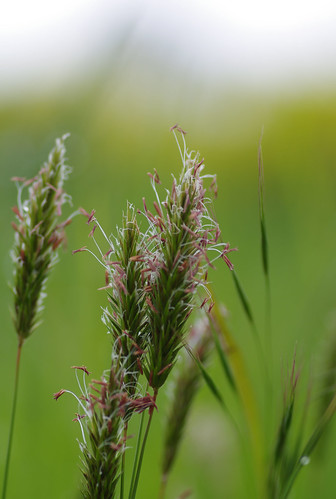
Flowering grass - not yet identified
Our first challenge of the day and I'm almost ashamed to reel out the usual type of excuse: i.e that grasses look completely different when flowering. In the days before everything was quantified and identified, I wonder how many different names existed for the same species, perhaps reflecting a variety of superstitions. How many names got lost in translation or went through the dialect mill to emerge into a different form?
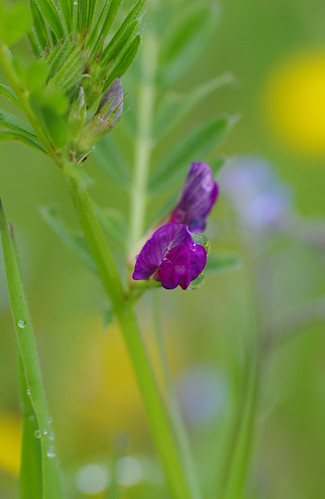
Common Vetch (Vicia sativa)
No such procrastination with our next find: its richly purple hue is unmistakeable.
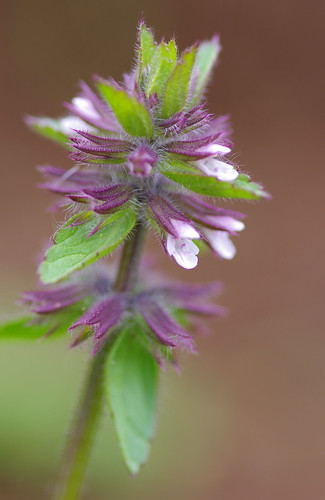
Basil Thyme (Clinopodium acinos)
These Basil Thyme flowers were colonising large sections of the meadow at ground level. As I came across more and more specimens, I could not help wondering whether the deep churning up of the ground had actually helped their proliferation. Had the seeds been given a helping hand and raised to the surface? Or had there been a planting scheme to regenerate a habitat that had existed long before I had deigned to call this local meadow one of my stomping grounds?

Early-purple Orchid (Orchis mascula)
Orchids were also staking their claim. Again, there can be colour variations for each species. The lower flowers develop first before the spike at the crown. Elsewhere in the meadow there were straggly tangles of Field Madder, plus a trailing yellow flower we could not trace which seemed to have three petals instead of four. There were Long-stalked Crane's-bills and Cut-leaved Crane's-bills, Common Spotted-Orchids and a plenitude of other plants and grasses we couldn't quite get a handle on.
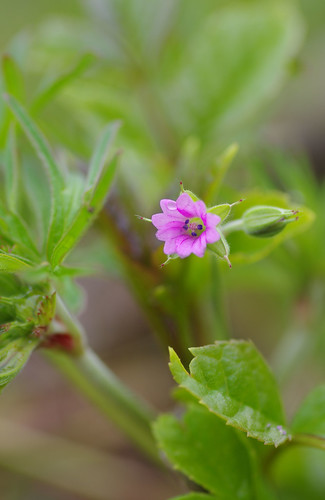
Cut-leaved Crane's-bill (Geranium dissectum)
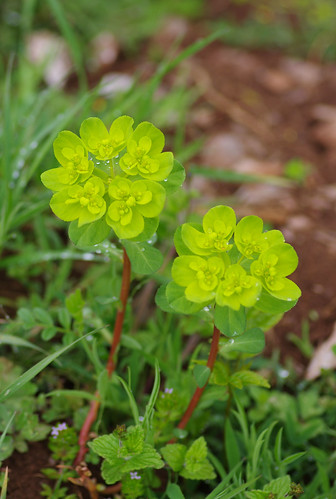
Sun Spurges (Euphorbia helioscopia)
This inviting pair were thriving in the margins of the meadow. There were no other spurges present as far as we were aware.
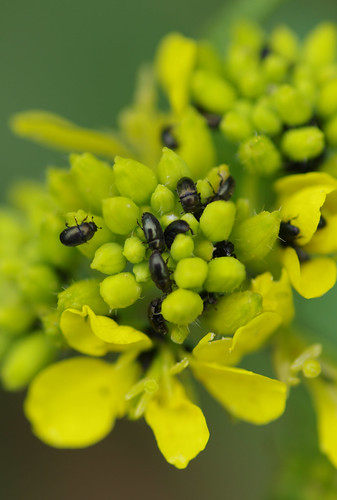
We found beetles swarming over these yellow flowers and liked the formation. Take away the legs and the black insects could almost be buds that have gone to seed!

Cleavers (Galium aparine)
Cleavers (also known as Goosegrass) is commonly found along hedgebanks and field margins. When you see a common plant over and over, it is easy to take it for granted. And then another time it's different and you find yourself looking with new eyes, as if for the first time.
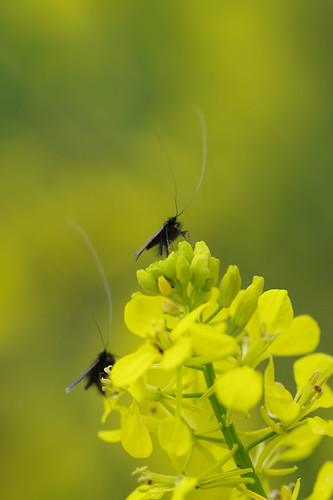
Micro moth species (Adela cuprella)
Although a common species, they were absent from my moth guide. The sea of yellow flowers was alive with them and their comical antennae. I was trying to think of an equivalent. I wonder how well we humans would fare with a pair of fifty foot long fishing rods strapped to our heads. The resulting movement might not be the graceful ballet we witnessed the moths embarking on, again and again.
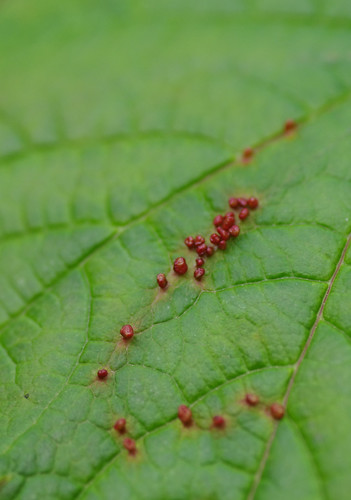
Aceria macrorhynchus
These galls often make interesting patterns on sycamore leaves. Sometimes they are clustered together and sometimes you will find them situated along the veins of leaves. We had left the meadow behind and gone under the mixed woodland canopy. Sanicle (an umbellifer and Ancient Woodland indicator) was by the narrow paths I elected to follow. We had to get down the hill somehow and I thought I would put my local knowledge to full advantage. I thought I chose the best path (being both a shortcut and appearing less steep than the others). But the path had a surprise in store and caught me unawares. I went right down on my backside and slid for a bit before recovering.
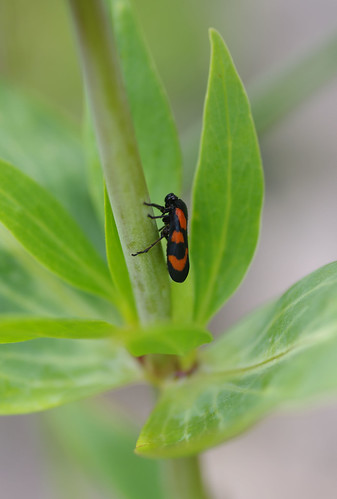
Cercopis vulnerata
We saw several of these froghoppers. This one was perched on a valerian stem near the steps leading away from Churston Cove.
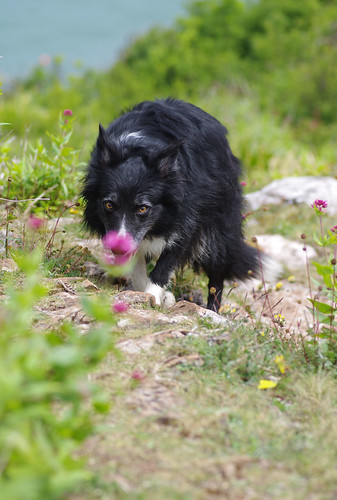
Send in the clown.

A head for heights.
We had gone down towards the limestone cliffs. One more habitat to explore and our efforts were duly rewarded. Growing out of the rocks and the thin soils were Salad Burnets and groups of delicate, papery rock rose flowers.

Common Rock-rose (Helianthemum nummularium)
There were groups of Rock Roses together but this solitary one caught our attention. Leaning forward, with side stems like arms poised, it looked like it wanted to jump and end it all.

Ivy Broomrape (Orobanche hederae)
We left the coast behind and went back through the woodland. For the final leg of our short walk, we turned right along a lane known locally as 'the Old American Road'. I always look out every year for the broomrapes. These were possibly the brightest coloured specimens I had seen. And I was also able to positively identify them afterwards thanks to the combination of colouring and the two yellow stigmas inside the flower roughly in the centre of the picture.
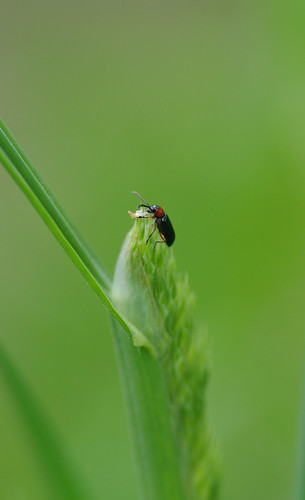
Oulema melanopa
This species of leaf beetle was climbing its own mountain, possibly to feed on tiny bugs within the crest of the grass. A couple of hundred yards later, we reached the end of our walk and began to contemplate all the wonderful flowers and insects we had encountered. I would never have imagined that a place I had been through literally hundreds of times over the years could yield so many new species in one day. It just goes to prove how diverse Devon's various habitats are when you examine them closely.
I only hope these prescious habitats will be preserved for future generations and be safe from the sustained pressures of house and road-building that have reduced our green and pleasant land to a fraction of its former glory.

Comments
Add a Comment